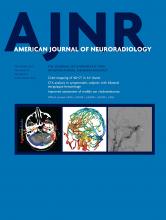Abstract
BACKGROUND AND PURPOSE: Intrasaccular flow diversion offers a promising treatment option for complex bifurcation aneurysms. The purpose of this study was to compare the flow conditions between successfully occluded and incompletely occluded aneurysms treated with intrasaccular devices.
MATERIALS AND METHODS: The hemodynamics in 18 completely occluded aneurysms after treatment with intrasaccular devices was compared against 18 that were incompletely occluded at follow-up. Hemodynamic and geometric parameters were obtained from computational fluid dynamics models constructed from 3D angiographies. Models of the intrasaccular devices were created and interactively deployed within the vascular models using posttreatment angiography images for guidance. Hemodynamic and geometric variables were compared using the Mann-Whitney test and univariate logistic regression analysis.
RESULTS: Incomplete occlusion was associated with large posttreatment mean aneurysm inflows (P = .02) and small reductions in the mean inflow rate (P = .01) and inflow concentration index (P = .03). Incompletely occluded aneurysms were larger (P = .002) and had wider necks (P = .004) than completely occluded aneurysms and tended to have more complex flow patterns, though this trend was not significant after adjusting for multiple testing.
CONCLUSIONS: The outcome of cerebral aneurysm treatment with intrasaccular flow diverters is associated with flow conditions created immediately after device implantation. Flow conditions unfavorable for immediate and complete occlusion seem to be created by improper positioning or orientation of the device. Complete occlusion is more difficult to achieve in larger aneurysms, aneurysms with wider necks, and aneurysms with stronger and more complex flows.
ABBREVIATIONS:
- AR
- aspect ratio
- Asize
- aneurysm size
- AUC
- area under the curve
- BF
- bottleneck factor
- corelen
- vortex corelen length
- ICI
- inflow concentration index
- UI
- undulation index
- NSI
- nonsphericity index
- Nsize
- neck size
- Q
- mean aneurysm inflow
- Qpost
- posttreatment aneurysm inflow rate
- VE
- mean aneurysm velocity
- VO
- mean vorticity
- VOR
- volume-to-ostium ratio
- © 2019 by American Journal of Neuroradiology
Indicates open access to non-subscribers at www.ajnr.org







